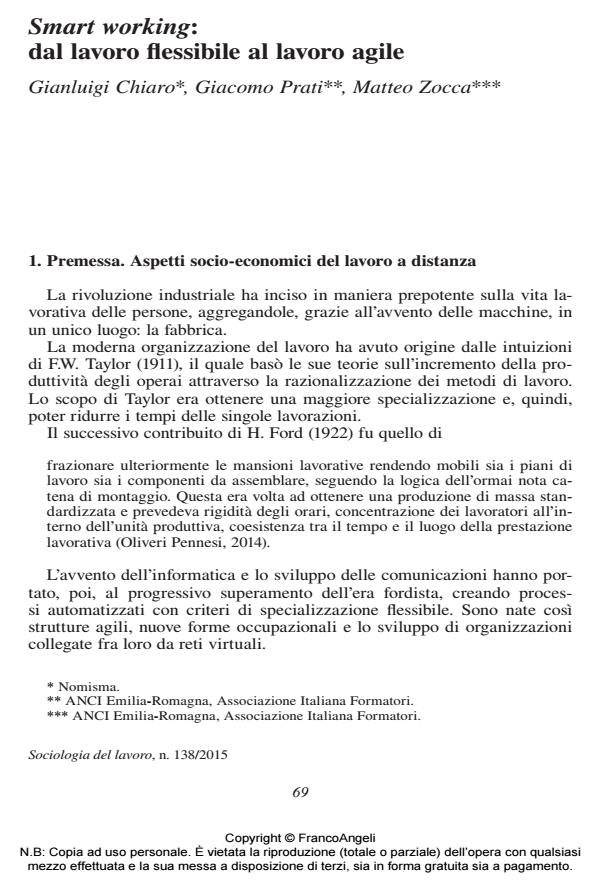Smart working: dal lavoro flessibile al lavoro agile Gianluigi Chiaro, Giacomo Prati, Matteo Zocca 005 From home working to smart working
Journal title SOCIOLOGIA DEL LAVORO
Author/s Gianluigi Chiaro, Giacomo Prati, Matteo Zocca
Publishing Year 2015 Issue 2015/138 Language Italian
Pages 19 P. 69-87 File size 181 KB
DOI 10.3280/SL2015-138005
DOI is like a bar code for intellectual property: to have more infomation
click here
Below, you can see the article first page
If you want to buy this article in PDF format, you can do it, following the instructions to buy download credits

FrancoAngeli is member of Publishers International Linking Association, Inc (PILA), a not-for-profit association which run the CrossRef service enabling links to and from online scholarly content.
This paper describes the historical development of remote working: from teleworking to smart working. The article analyses the development of teleworking in recent years, particularly in Italy, offering a comparison with other European countries. It explores the role that technologies have had in the expansion of this practice, and focuses on the limits and potential of its natural evolution: the "smart work". Through the presentation of recent regulations issued by governments, it is assumed, finally, that the smart working could be a real opportunity for organizations to empower their human resources. It is believed that, through these modern forms of labor flexibility, it is possible to develop the ability of autonomy of workers and, at the same time, to pay more attention to the needs of the individual, increasingly looking for a balance between work and private life.
Keywords: Smart working, home working, flexibility, information communication technology, remote working, work life balance
- Barbier J.C., Nadel H. (2002). La flessibilità del lavoro e dell’occupazione. Roma: Donzelli.
- Cantelmi T., Talli M. (novembre-dicembre 1998). Fenomeni correlati all’Internet Addiction Disorder: prime esperienze in Italia, aspetti clinici e note critiche. Psicologia Contemporanea, Milano: Giunti.
- Carli S. (21 ottobre 2013). Smart working, il lavoro 2.0 tra cloud, mobile e social network. Ciacia C., De Nicola P. (2001). Manuale sulle best practice del telelavoro. Roma: Officina Next.
- Consiglio europeo (1997). Bozza dei principi e linee guida sul telelavoro. Corriere Comunicazioni (15 ottobre 2014). Smart working, solo l’8% delle aziende italiane sposa il lavoro flessibile. Covey S.R. (2008), La sfida della fiducia, Milano: FrancoAngeli.
- D’Amato V. (2014), Management 3.0. Il manifesto e le nuove competenze per un manager. Milano: FrancoAngeli.
- D’Atri A., a cura di (2004). Innovazione organizzativa e tecnologie innovative. Milano: Etas.
- Di Nicola P., a cura di (1997), Il Manuale del telelavoro. Roma: Seam.
- Economist (2 marzo 2013). Mayer culpa. Ettighoffer D. (1993), L’impresa virtuale. I nuovi modi di lavorare. Padova: Muzzio.
- Eurofound (2000-2005-2010). European Working Conditions Surveys (EWCS). Testo disponibile al sito: http://eurofound.europa.eu/surveys/ewcs.
- Eurofound (2010). Telework in the European Union.
- Ferrari E. (n. 6 - 2013). Lavorare intelligente conviene. Modena Economica.
- Ford H. (1922), My Life And Work. Doubleday Page.
- Goldberg I. (1995). Internet Addiction Disorder.
- ISTAT (19 dicembre 2013). Cittadini e nuove tecnologie.
- Leonardi C. (3 ottobre 2013). Aziende e smart working: così si risparmiano 10 miliardi.
- Lodi Rizzini C. (5 dicembre 2013). Lavoro “agile”: di cosa parliamo? Percorsi di Secondo Welfare.
- Mattalucci L. (2014). Il crescente interesse per il tema dello “smart working”.
- Olivieri Pennesi S. (2014). Dove (è) il lavoro. Saggi su aspetti socio-economici. Ariccia (RM): Aracne.
- Olivieri Pennesi S. (2014). Il lavoro si evolve in smart working. Lavoro@Confronto - Numero 4 - Giugno/Luglio 2014.
- Passerini W. (15 ottobre 2014). Telelavoro, smartphone, tablet & Co. Cresce l’esercito degli smart worker. La Stampa.
- Politecnico di Milano (2012-2013). Osservatorio Smart Working, 2012-2013.
- Taylor F.W. (1911). The Principles of Scientific Management. New York: Harper and Brothers. Wireless4innovation (17 ottobre 2013). Tetra Pak. Le tecnologie aiutano lo smart working.
- WOW (Ways Of Working) (5 aprile 2013). OfficeTeam: ufficio del futuro 2020.
- Coworking (ISBN:978-88-5518-391-8)
- HR Analytics and Digital HR Practices Lucio Todisco, Gianluigi Mangia, Paolo Canonico, Andrea Tomo, pp.51 (ISBN:978-981-16-7098-5)
- Need for space. How artists rely on space to face precarious work conditions Damiano Razzoli, Stefano Rodighiero, Lorenzo Mizzau, Fabrizio Montanari, in SOCIOLOGIA DEL LAVORO 157/2020 pp.164
DOI: 10.3280/SL2020-157009 - ‘Another work routine is possible’: everyday experiences of (unexpected) remote work in Italy Alessandro Gandini, Emma Garavaglia, in Culture and Organization /2023 pp.397
DOI: 10.1080/14759551.2023.2201003 - Exploring Digital Resilience Sabrina Bonomi, Daria Sarti, Teresina Torre, pp.261 (ISBN:978-3-031-10901-0)
- Isolamento professionale e inclusione nell'esperienza del lavoro da remoto durante la pandemia in Italia Micol Bronzini, Enrico Cori, Daria Sarti, Teresina Torre, in PRISMA Economia - Società - Lavoro 1/2023 pp.68
DOI: 10.3280/PRI2022-001005 - Working in Digital and Smart Organizations Teresina Torre, Daria Sarti, pp.249 (ISBN:978-3-319-77328-5)
- Organizing in a Digitized World Enrico Cori, Daria Sarti, Teresina Torre, pp.41 (ISBN:978-3-030-86857-4)
Gianluigi Chiaro, Giacomo Prati, Matteo Zocca, Smart working: dal lavoro flessibile al lavoro agile in "SOCIOLOGIA DEL LAVORO " 138/2015, pp 69-87, DOI: 10.3280/SL2015-138005